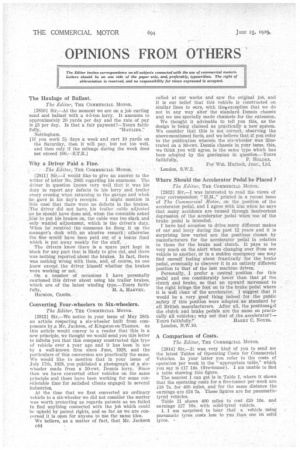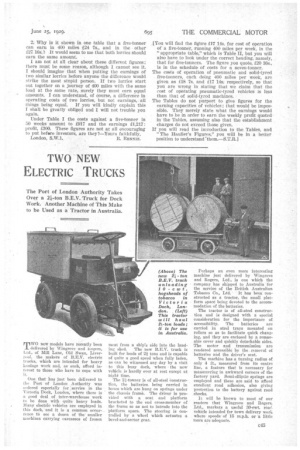OPINIONS FROM OTHERS
Page 66

Page 67

If you've noticed an error in this article please click here to report it so we can fix it.
The Haulage of Ballast.
The Editor, THE COMMERCIAL MOTOR.
[28101 Sir,—At the moment we are on a job carting sand and ballast with a 4-5-ton lorry. It amounts to approximately 20 yards per day and the rate of pay is £3 per day. Is that a fair payment?—Yours faith
fully, "HAULIER." Nottingham.
[If you work 5i days a week and cart 10 yards on the Saturday, then it will pay, but not too well, and then only if the mileage during the week does not exceed 100.—S.T.R.]
Why a Driver Paid a Fine.
. The Editor, Tat COMMERCIAL MOTOR.
. .
12811] Sir,—I would like-to give an answer to the -writer of letter No. 2805 regarding his summons. The
• driver in question knows very Well that it was his duty to report any defeets to his lorry and trailer every evening when returning to the garage and when he gave in his day's receipts. I might mention in this case that there were no defects in the brakes. The driver did not have, his trailer cable adjusted as he should have done and, when the constable asked him to put his brakes on, the cable was too slack and only wanted adjustment, which is the driver's duty. When he received the summons he flung it on the manager's desk with an abusive remark; otherwise the fine would have been paid out of a bonus fund which is put away weekly for the staff.
The drivers know there is a spare part kept in stock for any part that is likely to give out, and there was nothing reported about the brakes. In fact, there was nothing wrong with them, and, • of course, no one knew except the driver himself 'whether the brakes were working or not. On a number of occasions 7 have personally cautioned this driver, about uSing his trailer brakes, which are of the latest winding type.—Yours faith Converting Four-wheelers to Six-wheelers.
The Editor, THE COMMERCIAL MOTOR.
[2812] Sir,—We notice in your issue of May 28th an article respecting a six-wheeler built from components by.a Mr. Jackson, of Kingston-on-Thames. As this article would convey to a reader that this is a new principle, we thought we would send you this letter to infoim you that this company constructed this type of vehicle over a year ago and it has been in use by a well-known firm since June, 1928, and the Particulars of this conversion are practically the same. We would like to mention that in your issue of July 17th, 1928, you published a photograph of a sixwheeler made from a 30-cwt. Dennis lorry. Since then we have converted other vehicles on the same principle and these have been working for some considerable time for satisfied clients engaged in several industries.
At the time that we first converted an ordinary vehicle to a six-wheeler we did not consider the matter was worth protecting as regards patents as we failed to find anything connected with the job which could be upheld by patent rights, and so far.as we are concerned it is open for anyone to use the same idea.
We believe, as a matter of fact, that Mr. Jackson c44 called at our works and saw the original job, and it is our belief that this vehicle is constructed on similar lines to ours, with thetexception that we do not in any way altei the standard Dennis chassis and we use specially made channels for the extension.
We thought it advisable to tell you this, as the design is being claimed as practically a new system. We consider that this is not correct, observing the above-mentioned facts, and we believe that if you refer to the publication wherein the six-wheeler was illustrated on a 30-cwt. Dennis chassis in your issue, this, we think you will agree, is the same type which has been adopted by the gentleman in question.—Yours
faithfully, P. HOLDER,
For Wth. Hurlock, 3uur., Ltd.
London, S.W.2.
Where Should the Accelerator Pedal be Placed ?
The Editor, TEE COMMERCIAL MOTOR.
[2813] Sir,—I was interested to read the views of • your correspondent " H.M.," printed in a recent issue of The Commercial Motor, on the position of the accelerator pedal, and I agree with him when he says that many accidents are Caused through inadvertent depression of the accelerator pedal when use of the brake pedal is intended.
I have had Occasion to drive many different makes of car and lorry during the past 12 years and it is surprising how varied are the positions chosen by manufacturers for the accelerator pedal in relation to those for the brake and clutch. It pays to be very much on the alert when changing over from one vehicle to another, or in a sudden emergency one may find oneself feeling about frantically for the brake pedal, eventually to discover it in an entirely different position to that of the last machine driven. •
Personally, I prefer a central position for this pedal and one considerably lower than that of the clutch and brake, so that an upward movement to the right brings the foot on to the brake pedal where it is well clear of the accelerator. I suggest that it would be a very good thing indeed for the public safety if this position were adopted as standard by all British manufacturers. After all, the positions.tof the clutch and brake pedals are the same on practically all vehicles; why not that of the accelerator?— Your HARRY C. NOTES.
London, N.W.10.
A Comparison of Costs.
The Editor, TEE COMMELDIAL MOTOR.
[2814] Sir,—It was very kin,d of you to send me the latest Tables of Operating Costs for Commercial Vehicles. In your letter you refer to the costs of operation per week in the "appropriate table," which you say is £17 14s. (five-tonner). I am unable to find a table showing this figure.
The nearest I can get is in Table I, where it shows that the operating costs for a five-tonner per week are £18 7s. for 400 miles, and for the same distance the earnings are £24 7s. These figures are for pneumatictyred vehicles. Table II shows 400 miles to cost £20 10s. and earnings £27 16s. with solid-tyre d vehicle. 1. I am surprised to hear that a vehicle using pneumatic tyres _costs less to run than one on solid tyres. •
2. Why is it shown in one table that a five-tonner can earn in 400 miles £24 7s., and in the other £27 16s-.? It would seem to me that both lorries should earn the same amount.
I am not at all clear about these different figures; there must be some reason, although I cannot see it. I should imagine that when putting the earnings of two similar lorries before anyone the difference would strike the most stupid person. If two lorries start out together on a journey of 400 miles with the same load at the same rate, surely they must earn equal amounts. I can understand, of course, a difference in operating costs of two lorries, but not earnings, all things being equal. If you will kindly explain this I shall be greatly obliged and I will not trouble you again.
Under Table I the costs against a five-tormer In 50 weeks amount to £917 and the earnings £1,217: profit, £300. These figures are not at all encouraging to put befwe investors, are they?—Yours faithfully, London, S.W.1. R. RENNIIii. [You will find the figure £17 14s. for cost of operation of a five-tanner, running 400 miles per week, in the "appropriate table," which is Table II, but you will also have to look under the correct heading, namely, that for five-tonners. The figure you quote, 120 16s., is in the schedule of costs for a seven-tonner.
The costs of operation of pneumatic and solid-tyred five-tonners, each doing 400 miles per week, are given as £18 7s. and £17 149. respectively, so that you are wrong in staling that we claim that the cost of operating pneutnatic-tyred vehicles is less than that of solid-tyred machines.
The Tables do not purport to give figures for the earning capacities of vehicles; that would be impossible. They merely state what the earnings would have to be in order to earn the weekly profit quoted in the Tables, assuming also that the establishment charges do not exceed those given.
If you will read the introduction to the Tables, and "The Haulier's Figures," you will be In a better position to understand `them.—S.T.R.]












































































































